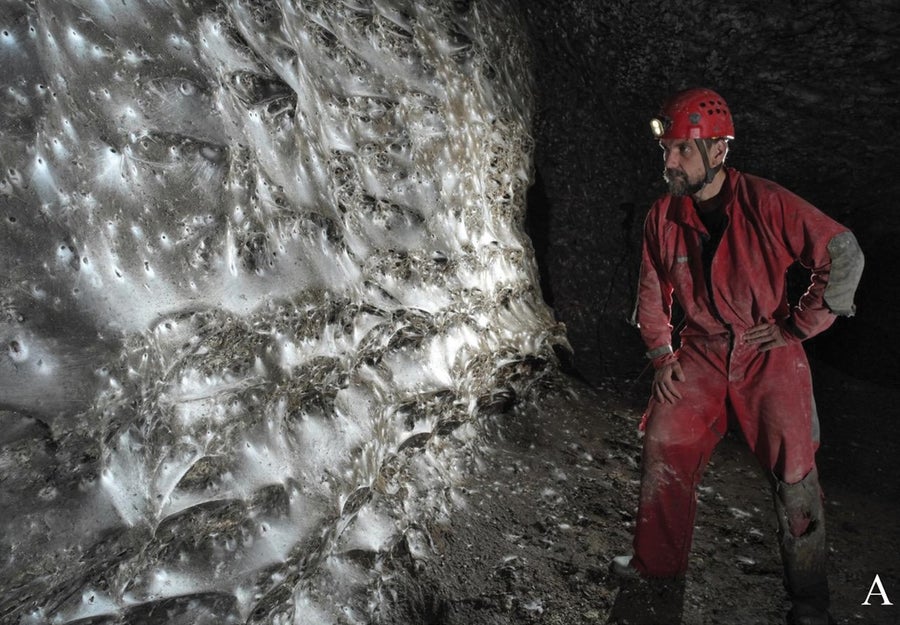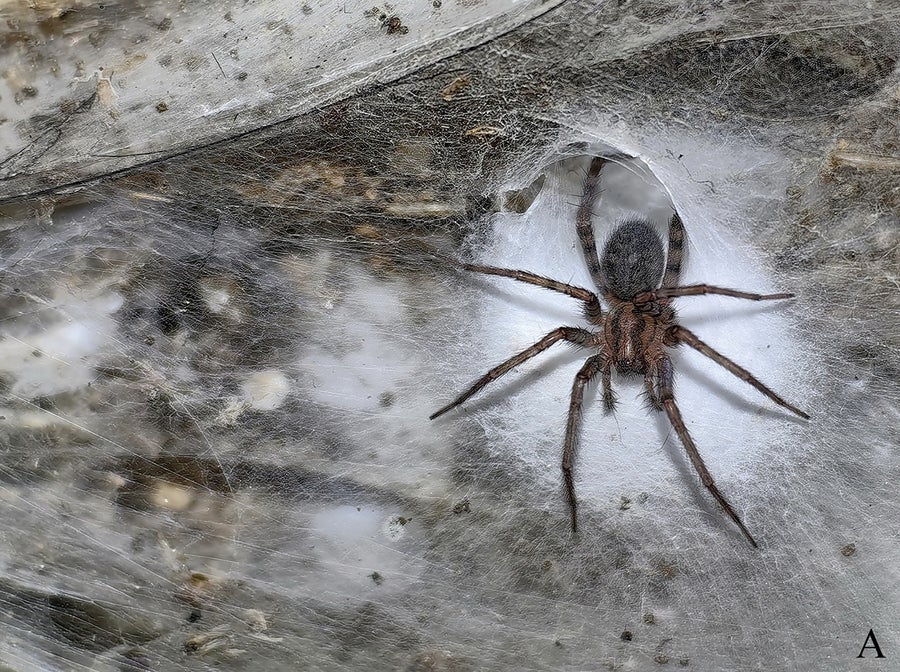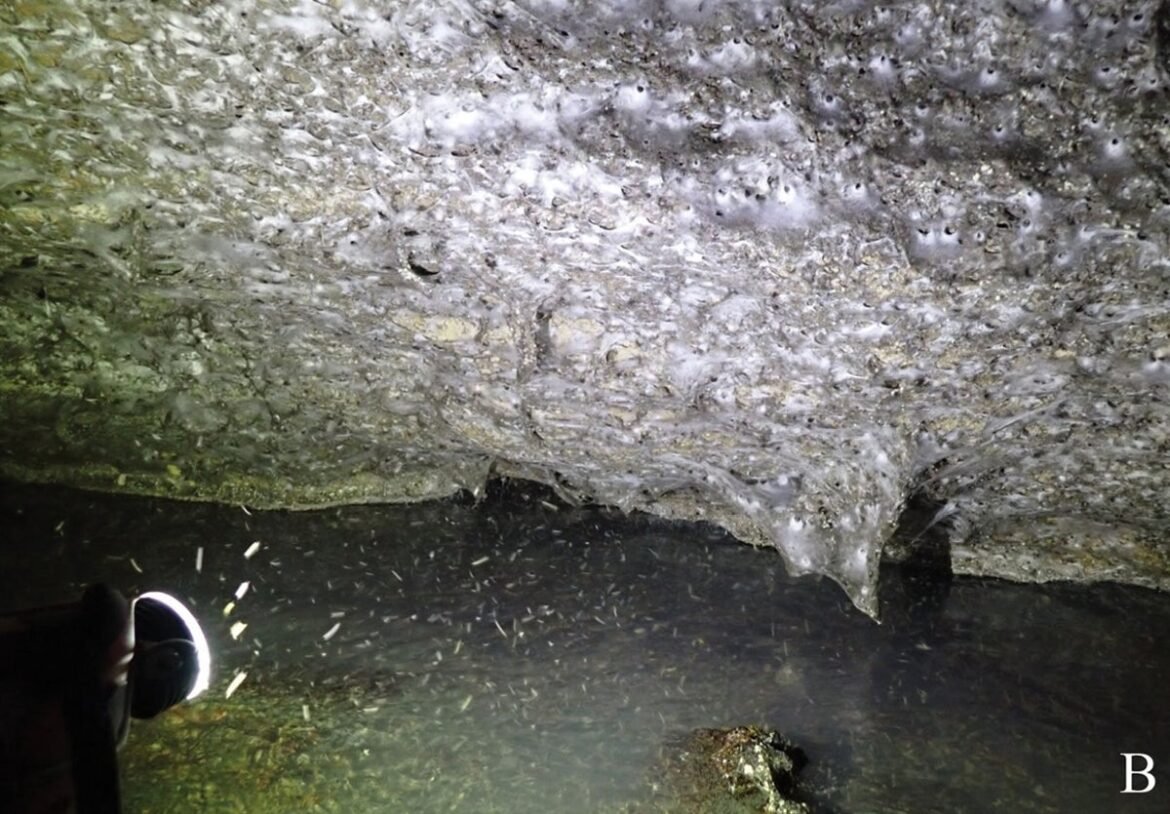November 7, 2025
2 min read
This Cave Holds a Spider Web “Megacity” the Size of Half a Tennis Court
The finding is the first documented case of colonial behavior between two solitary species
Lights illuminate the massive spider web found in the cave on the border of Greece and Albania.
From “An extraordinary colonial spider community in Sulfur Cave (Albania/Greece) sustained by chemoautotrophy” by István Urák et al., in Subterranean Biology, 53: 155-177; October 17, 2025 (CC BY 4.0)
While exploring a sulfur cave on the Albania-Greece border, scientists at the Czech Speleological Society discovered the largest spider web ever recorded. The vast “megacity,” spanning more than 1,040 square feet —nearly half the size of a tennis court—is home to about 111,000 spiders of the species Tegenaria domestica and Prinerigone vagans, according to a study by a separate group of researchers. This is the first documented case of either of these two species constructing webs together, the study’s authors reported recently in Subterranean Biology.

A caver looks at the massive colonial spider web.
Sulfur caves are among the most extreme habitats on Earth. They are completely dark and filled with hydrogen sulfide gas, which is toxic to most life-forms. Inside, species’ survival depends on chemical reactions powered by microbes that oxidize sulfur. These microorganisms are the base of a unique food chain that supports a community of cave-dwelling organisms.
On supporting science journalism
If you’re enjoying this article, consider supporting our award-winning journalism by subscribing. By purchasing a subscription you are helping to ensure the future of impactful stories about the discoveries and ideas shaping our world today.
To understand how the spiders survive in this environment, the team analyzed the chemical signatures in their tissues, which revealed that the arachnids feed on tiny midges that hatch from cave pools. Those flies themselves depend on sulfur-oxidizing microbes as their primary food source.

Tegenaria domestica on the spider web.
From “An extraordinary colonial spider community in Sulfur Cave (Albania/Greece) sustained by chemoautotrophy” by István Urák et al., in Subterranean Biology, 53: 155-177; October 17, 2025 (CC BY 4.0)
A genetic analysis showed that the cave-dwelling spiders are becoming distinct from populations of the same species that live outside, suggesting they are adapting to the underground environment, the researchers wrote. They think that this genetic isolation, combined with a stable and abundant food supply, may have driven these species—which have never been reported to form colonies—to evolve colonial behavior.
The new finding “shows that nature still holds many surprises for us,” says study co-author Urák István of the Sapientia Hungarian University of Transylvania in Romania.
It’s Time to Stand Up for Science
If you enjoyed this article, I’d like to ask for your support. Scientific American has served as an advocate for science and industry for 180 years, and right now may be the most critical moment in that two-century history.
I’ve been a Scientific American subscriber since I was 12 years old, and it helped shape the way I look at the world. SciAm always educates and delights me, and inspires a sense of awe for our vast, beautiful universe. I hope it does that for you, too.
If you subscribe to Scientific American, you help ensure that our coverage is centered on meaningful research and discovery; that we have the resources to report on the decisions that threaten labs across the U.S.; and that we support both budding and working scientists at a time when the value of science itself too often goes unrecognized.
In return, you get essential news, captivating podcasts, brilliant infographics, can’t-miss newsletters, must-watch videos, challenging games, and the science world’s best writing and reporting. You can even gift someone a subscription.
There has never been a more important time for us to stand up and show why science matters. I hope you’ll support us in that mission.



